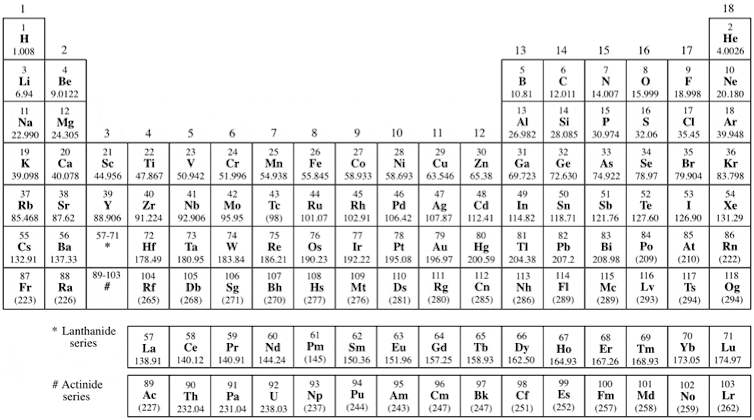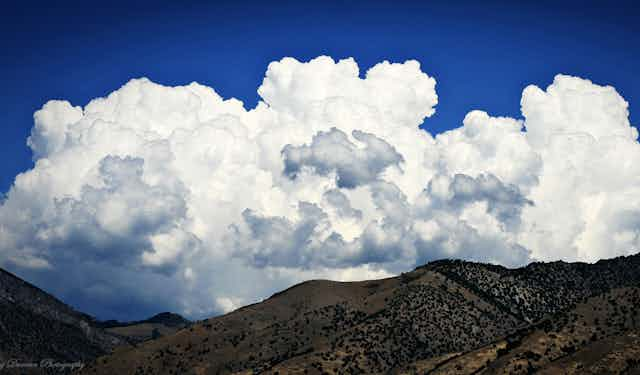This is an article from Curious Kids, a series for children of all ages. The Conversation is asking young people to send in questions they’d like an expert to answer. All questions are welcome. Skip to the bottom to see how to enter.
How do the clouds stay up in the sky? – Samson, age four, London, UK.
Thanks for the question, Samson. Believe it or not, I once weighed a cloud and not many people can say they have done that! My scientist friends and I flew up into the sky in a giant airship, and went all the way through a fluffy, white cloud. Actually, it was very wet up there, because clouds are made up of billions of tiny water droplets.
As we flew through the cloud, we used lasers and other special scientific devices to measure how big the cloud was, and count how many tiny droplets of water were in it. Then, we did some maths and found that this cloud – which was actually pretty small, for a cloud – weighed four tonnes. That’s the same as two elephants! So, you’re right to wonder how such a heavy thing can stay up in the sky.
There are three pieces to this puzzle, and the first one is gravity. Like everything on this planet, the tiny droplets that make up a cloud are drawn towards the Earth by gravity. But these droplets are so small that it’s hard for them to push past all the air beneath them. This means that they don’t fall very fast at all – in fact, only about one centimetre per second. And any wind blowing upwards can carry the droplets back up.
To fit the second piece of the puzzle, we’ll need to learn some proper chemistry; not too much, though, just enough for our story. Let me introduce the periodic table: a map of all the elements that we humans know about. Elements are the building blocks of all things – just like the smallest pieces of Lego, which you use to build bigger and more complex objects.
The periodic table is organised so that the lightest element of each row is always on the left. Hydrogen is the lightest of all elements, so you’ll find it at the top left. As you move along each row from left to right, the elements get heavier and heavier.

Click here for a larger, interactive version.
Dry air is mostly made up of two gases, nitrogen and oxygen, plus a little bit of argon and tiny amounts of other gases. For now, we can just focus on nitrogen and oxygen. As you can see on the periodic table, the weight of a single nitrogen atom is 14, while oxygen weighs almost 16.
But neither nitrogen nor oxygen atoms like to be alone, so they almost always go in pairs – two atoms in a molecule, like two peas in a pod. Because of this, a nitrogen molecule usually weighs 28, and an oxygen molecule weighs 32.
As soon as we add water (H₂O) to the air, things get interesting. A water molecule is made up of two hydrogen atoms and one oxygen atom. Remember how hydrogen is the lightest element? Well, a single water molecule weighs just 18. So it’s actually lighter than a molecule of nitrogen or oxygen. That’s why moist air is lighter than dry air.
The next piece of the puzzle is temperature. As a rule, warm air rises up, while cold air sinks down. When water in the air is warmer, it’s more likely to be a gas. When it’s cooler, it prefers to take a liquid form, such as cloud droplets, rain, hail or snow.

As warm, moist air rises, it gets cooler and cooler. And as it cools, more tiny water droplets form. You might expect the water droplets just to fall down as rain, but instead, something fun happens. You know how sweat cools our skin when it dries and changes from liquid into gas? Well, when gas turns into liquid, the exact opposite happens: it actually gives off heat.
This means that the cloud droplets are now surrounded by a tiny blanket of warm air. And what does warm air do? It rises! Not very far, though, because the air will cool again as it goes up.
Now our puzzle is complete: clouds are made up of tiny droplets of water, which are hardly affected by gravity, embedded in moist air, which is lighter than dry air. And they’re surrounded by tiny warm blankets of air, which lift them up towards the sky. That’s how clouds weighing billions of tonnes can stay afloat up in the sky.
Read more: Curious Kids: Why do you have to wear a helmet in space?
Hello, curious kids! Have you got a question you’d like an expert to answer? Ask an adult to send your question to us. You can:
* Email your question to curiouskids@theconversation.com
* Tell us on Twitter by tagging @ConversationUK with the hashtag #curiouskids, or
* Message us on Facebook.

Please tell us your name, age and which town or city you live in. You can send an audio recording of your question too, if you want. Send as many questions as you like! We won’t be able to answer every question, but we will do our best.
This article has been updated to reflect the effects of air resistance and gravity on cloud droplets more accurately.


